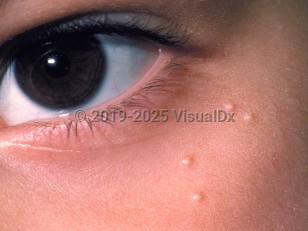Milia in Adult
See also in: External and Internal EyeAlerts and Notices
Important News & Links
Synopsis

Primary milia affect 40%-50% of newborns but may be found in patients of all ages.
Secondary milia often occur after cosmetic procedures (dermabrasion, chemical peels, ablative laser therapy) or trauma, or in conjunction with blistering disorders. Milia may occur in tattoos. Patients with skin phototypes IV through VI tend to be more likely to develop milia as sequelae of chemical peels. Blistering disorders that may heal with milia and scarring include epidermolysis bullosa acquisita; porphyrias, including porphyria cutanea tarda; bullous pemphigoid; herpes zoster; contact dermatitis (allergic, irritant); bullous lupus erythematosus; and dermatitis herpetiformis. Milia have also been known to occur in areas of topical steroid-induced atrophy. Persistent or widespread milia are associated with many syndromes (see Differential Diagnosis & Pitfalls).
Milia en plaque refers to a rare entity that typically occurs in the periauricular area.
Codes
L72.0 – Epidermal cyst
SNOMEDCT:
254679001 – Milia
Look For
Subscription Required
Diagnostic Pearls
Subscription Required
Differential Diagnosis & Pitfalls

Subscription Required
Best Tests
Subscription Required
Management Pearls
Subscription Required
Therapy
Subscription Required
Drug Reaction Data
Subscription Required
References
Subscription Required
Last Updated:08/01/2024
 Patient Information for Milia in Adult
Patient Information for Milia in Adult- Improve treatment compliance
- Reduce after-hours questions
- Increase patient engagement and satisfaction
- Written in clear, easy-to-understand language. No confusing jargon.
- Available in English and Spanish
- Print out or email directly to your patient


